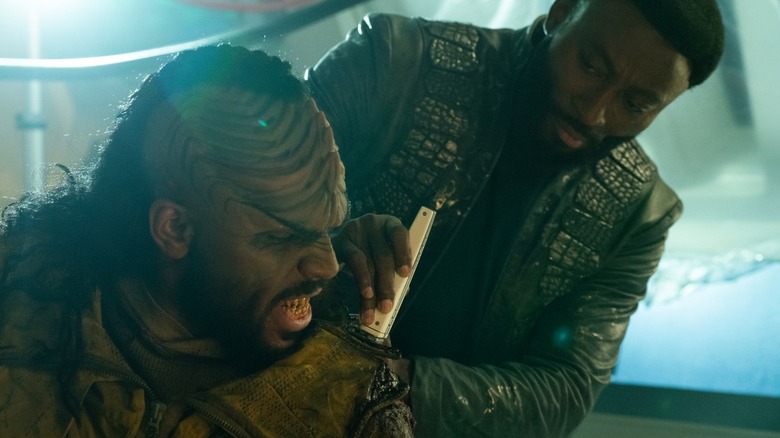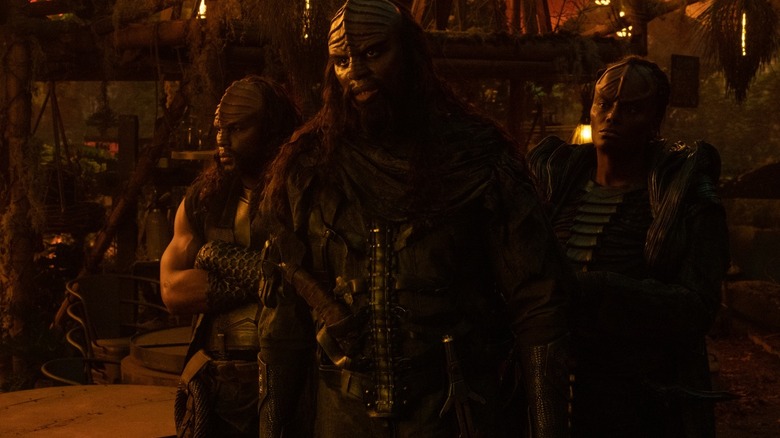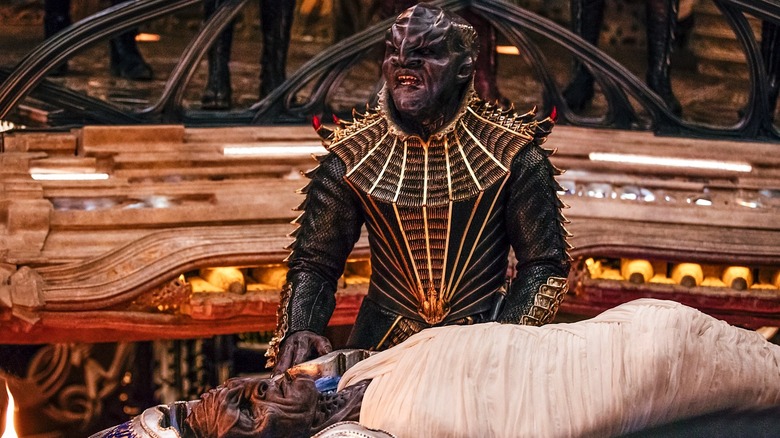Why Star Trek: Strange New Worlds Reversed Discovery's Controversial Klingon Change
When "Star Trek: Discovery" debuted in 2017, many Trekkies agreed to have an open mind. This was, after all, the first canonical, TV-bound piece of "Star Trek" media since the cancelation of "Star Trek: Enterprise" in 2005. It was the first Trek to appear on a (brand new) streaming service and was reported to have all the SFX bells and whistles that a giant budget might warrant. It was set about a decade prior to the original series, and its main character, Michael Burnham (Sonequa Martin-Green), was shockingly not a captain. The series was going to be about the Federation's war with the Klingons, an event in "Star Trek" history that had never been dramatized.
One of the more startling changes, however, was to the Klingons themselves. On "Discovery," they were given larger, elongated heads and were stripped of hair. Their eyes were given catlike slits, and their noses bore secondary pairs of nostrils (!). Their skin was jet black, deep purple, or pale like cream. This was a startling change from the way the Klingons looked from 1979 to 2005, when they had brown skin, long hair, pirate-like facial hair, and pronounced cranial ridges. Of course, in the 1966 series, Klingons looked more human, save their facial hair, so dramatic changes were already a part of Trek's larger canon. Perhaps the new "Discovery" designs merely needed to be gotten used to.
Not so. Slowly, the makers of new Trek programs moved back to the 1990s Klingons. In 2023, the Klingons have now appeared on "Star Trek: Strange New Worlds," and they are once again the lusty, head-ridged pirates of the "Next Generation" era, albeit slightly improved.
In a recent interview with Inverse, showrunners Akiva Goldsman and Henry Alonso Myers talked about why they made that choice.
New, old Klingons
While "Star Trek: Enterprise" would eventually find a canonical reason why the original series Klingons and NextGen Klingons look different (there was some extensive genetic tinkering going on a few centuries ago), Meyers and Goldsman were less concerned with notions of canon, and more concerned with presenting "Strange New Worlds" as its own entity. While the "Strange New Worlds" characters were introduced on "Discovery," Goldsman wanted to make sure that viewers didn't need to be familiar with one in order to enjoy the other. He said:
"It's really important that it's not a 'Discovery' sequel for people who don't watch Discovery.[...] What we try to do when it comes to the deeper dive into more canonical material is this: if you don't know about that stuff, it's a cool TV show that lives on its own. If you do know it, then it's an utter delight. But we never use [events in other shows] foundationally for story structure or emotion unless we re-explain it and recharge it so that it's new in the episode."
This is a careful balance, as Trekkies have notoriously always kept a close eye on canon and precedent. "Strange New Worlds," it seems, needs to be aware of precedent, but cannot rely on it. This is a wise approach for a show that would like to stand alone, and not be like the Marvel Cinematic Universe (which notoriously interlinks its various films and TV shows a little too closely). This hand-waving of canon, then, led to the drastic redesign of the Klingons.
Star Trek is not the MCU
Goldsman continued:
"'Star Trek' is not the MCU, even though there's a faux-U.S.S. Discovery in this episode, and the events of Discovery are referenced. 'Strange New Worlds' isn't worried about its roots, especially when it comes to Klingons. After a controversial redesign for 'Discovery' season one, the Klingons that appear in 'Strange New Worlds season two look more or less like the Klingons in most of canon, complete with those famous foreheads."
Meyers, meanwhile, said that the broad history of "Star Trek" was being more closely considered than "Star Trek: Discovery" in particular. That meant that every new show had the right to tinker with the Klingons' design as they saw fit. Klingons, after all, looked different in "Star Trek: The Motion Picture" than they did in "Star Trek," and then changed again for NextGen. With that precedent in place, Meyers felt it was fair to make big changes. He said:
"I think we were probably a little more influenced specifically by the look of the movies. [...] But the history that nobody talks about is that in almost every show, there has been a change in the way the Klingons look. And what 'Discovery' did was really interesting and it was specific and it was challenging. This was our chance to say that we were not changing or ruining anything that anyone else has done, but to do something that felt like its own, but very much coming from the world of the other Klingons."
The showrunners also eventually admitted they were motivated by practicality. The "Discovery" Klingons were way more complicated to realize than the NextGen designs, and budgets — both money and time — pushed them back into the classics. This, of course, makes the most sense.


